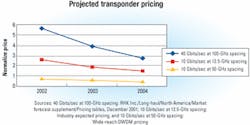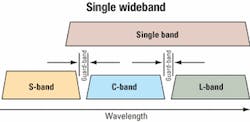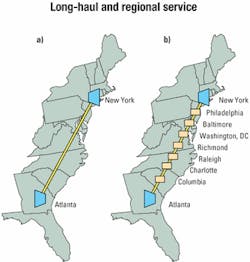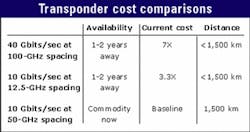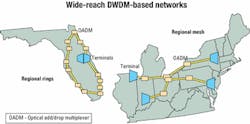'Wide-reach' DWDM system lowers network costs
A single wide transmission spectrum using low-cost transponders provides economic efficiency.
SHARLENE LIN, Xtera Communications
Carriers today are less preoccupied with "new generation" technology and networks and more with the lowest cost for delivering bandwidth. Lower startup cost, lower expansion cost, and lower operating expenses over the lifetime of the equipment are all essential to carriers that must deliver greater bandwidths with proportionally smaller increases to revenue.
Vendors have often manipulated the prices they charge for startup systems (the razor), significantly dropping the price of base systems and making up the loss over the life of the product in higher-priced transponders (the razorblades). These pricing tactics allow carriers to deploy more base systems, because in essence, the vendor has helped with the financing of the carrier's network. Through time, the carriers pay back the vendors by buying higher-margin transponders. Regardless of when they pay, carriers pay the full cost. Only vendors that can deliver the lowest-cost razor and lowest-cost razorblade can deliver the system with lowest overall cost.
Many DWDM vendors have looked toward maximizing capacity by increasing channel bit rates to 40 Gbits/sec or improving spectral efficiency within the C-band with tighter channel spacing to 12.5 GHz. These vendors plan to lower transport costs by leveraging improvements in technology, with the hope that component costs will drop with increasing volumes deployed.With all carriers reducing their capital budgets, the high volumes may not come to fruition. A more effective method for lowering costs in transport gear has been overlooked. Instead of relying on premature technology for cost improvements, innovative use of Raman technology provides a far greater opportunity. For example, a "wide-reach" DWDM system leverages the flexibility of Raman technology to lengthen the distance between costly electrical regenerators and optimize usable spectrum within fiber so low-cost commodity transponders can be deployed. Discrete Raman amplification is used for inline amplification, opening up 100 nm of usable spectrum, while distributed Raman is used to reverse-pump the line fiber, allowing signals to traverse up to 1,500 km without regeneration. A wide-reach DWDM system enables the lowest-cost transponders and amplifiers, resulting in the lowest-cost DWDM system available.
Wide spectrum in fiber has always been available for exploitation, but until now, it hasn't been used to deliver lower-cost transport solutions. Extending the efficient operating window of fiber from the 35 nm available in the C-band to a wide 100 nm affords carriers the opportunity to use low-cost commodity transponders to achieve greater bandwidth, distance, and scalability at the lowest price.
With 100 nm of spectrum, 50-GHz-spaced transponders allow a wide-reach DWDM system to grow to 240 channels, adequate capacity for any foreseeable expansion. The technology for 10-Gbit/sec, 50-GHz-spaced transponders is mature and reliable and has benefited from the ride down the steep technology cost curve.
The Table offers a comparison of transponder prices. Transponders for 10 Gbits/sec designed to operate at 12.5-GHz spacing will cost 3.3 times (or more) the price of 50-GHz devices, while 40-Gbit/sec transponders designed to operate at 100-GHz spacing will cost seven times the cost of 10-Gbit/sec, 50-GHz-spaced transponders. The added costs in 12.5-GHz-spaced transponders lie in tighter-tolerance multiplexers/demultiplexers, laser stabilization techniques, and methods incorporated to mitigate nonlinear interactions. Added costs in 40-Gbit/sec transponders lie in the costs incurred to mitigate chromatic dispersion and polarization-mode dispersion and perform high-speed multiplexing and demultiplexing.Furthermore, without additional improvements in technology and added cost, the 12.5-GHz-spaced transponder and 40-Gbit/sec transponder cannot operate to 1,500 km on even singlemode fiber without capacity penalties. Simply put, the cost of advanced transponders is high.
Since transponders represent at least 70% of full system costs, a DWDM system that allows the lowest-cost transponders offers carriers greater savings initially and over the lifetime of the equipment. A wide-reach DWDM system delivers the greatest capacity with the lowest transponder costs, minimizing total transport costs. Over the next several years, 10-Gbit/sec, 50-GHz-spaced transponder technology should continue to be the best value as well (see Figure 1).
According to market researcher RHK Inc.'s December 2001 report, "Long-haul Transport & Optical Networks: North America," the 600-1,500-km category for DWDM systems is experiencing 40% annual growth, reaching $1.5 billion in 2005. New-generation DWDM systems incorporate technology that aids in achieving higher capacity at these greater distances. Vendors make use of distributed Raman amplification, solitons, or other technologies to lengthen the distance between costly regeneration sites.
A wide-reach DWDM system leverages both discrete and distributed Raman amplification, in combination, to realize expanded capacities together with extended distance. Additional benefits arise from tighter integration, fewer parts, and reduced space requirements to achieve lower cost. With an all-Raman approach, a 100-nm wide-reach DWDM system can be achieved at cost parity with 35-nm C-band DWDM systems.
When both discrete and distributed components are integrated into a single amplifier, pump power is more efficiently utilized and there is improved control of the spectral gain profile across the 100 nm, resulting in superior management of added and dropped channels. With no banding, guard bands between the C-, L-, and S-bands are unnecessary (see Figure 2). All of the 100-nm bandwidth is usable, maximizing spectral efficiency.
Using 50-GHz spacings, 240 channels can be supported in this window. Together with the distributed Raman component, all 240 channels can operate across 1,500 km simultaneously. Capacity does not have to be traded for distance. No couplers are needed to add bands, eliminating up to 2-3 dB of the loss reserved by banded DWDM systems. Band separation multiplexing/demultiplexing is eliminated. No upgrades are required at inline amplifiers (ILAs) to achieve capacity beyond each 35-nm band increment. The simplified, single-amplifier design results in added reliability, improved product density, and lower cost.A unidirectional banded DWDM system uses one erbium-doped fiber amplifier (EDFA) for inline amplification and a separate distributed Raman amplifier for distance. Therefore, four amplifiers are needed to support 80 10-Gbit/sec channels, east and west, at an ILA site. To upgrade to the 81st channel, another 35 nm of spectrum must be enabled. Two L-band amplifiers must be added at each site, increasing costs by a factor of two. Previously deployed distributed Raman amplifiers must be modified or replaced, and power-level adjustments must be made to in-service circuits at every ILA site. To deliver the 161st channel, an entire overlay network must be put in place, requiring yet more equipment and additional fiber.
The upgrades are expensive and time-consuming, requiring truck roll, personnel coordination, and potential service interruption. As well, ad ding the second EDFA can often result in power-management issues and gain tilt, reducing the capacity of the second amplifier.
Since an all-Raman DWDM system is wide-reach, only two Raman amplifiers (east and west) need to be deployed at each site. These two amplifiers enable 100 nm at the onset. The 100-nm DWDM system is 240-channel-ready for the same price as the 35-nm C-band-based system. Each ILA can support the full 240 channels without future upgrades or additional costs. The 8lst channel needs only a transponder on each end. No additional power balancing of the C-band to compensate for the L-band is required. No visit to the remote huts is necessary. The entire system grows using the same inexpensive 50-GHz-spaced transponders.Perhaps 80 channels of 10-Gbit/sec wavelengths are adequate growth for a point-to-point long-haul link over the foreseeable future. Now, there are an additional 160 channels available on the fiber at no additional cost. This free capacity can be used to address additional markets and revenue opportunities. Services can now be delivered to intermediate cities along the link.
With traditional DWDM systems, each optical add/drop multiplexer (OADM) in a link reduces the link-loss budget. Planners must trade off maximum link distances to service more cities. With a wide-reach DWDM system, every site can be an OADM, with no penalty on distance.
A wide-reach DWDM system allows in-service growth of ILAs to OADMs, a tremendous cost savings for carriers. Take, for example, a route between Atlanta and New York (see Figure 3). This 1,400-km route includes such major cities as Columbia, Raleigh, Charlotte, Richmond, Washington, DC, Baltimore, and Philadelphia.
Traditionally, OADMs are purchased and installed during initial network build-out, prior to any service delivery. Upgrading ILAs to OADMs later requires out-of-service hits on traffic-a costly proposition for carriers. Although maximizing OADMs in a link enables more serviceable markets, planners limit the number of OADMs to one or two, because each OADM requires a tradeoff on the maximum link distance.
A wide-reach DWDM system is architected for in-service growth of ILAs to OADMs and has no distance penalty for each OADM added. As such, carriers using a wide-reach DWDM network can deliver services to cities unserviceable by others.
To deliver bandwidth to all these cities using banded DWDM systems, the network would require costly optical-electrical-optical (OEO) regeneration and additional pre-deployed OADMs, causing the initial cost of an Atlanta-to-New York route to double or triple that of a wide-reach DWDM network.
For long-haul links between 500 and 1,500 km, the base system accounts for 30% of full system costs. First costs are significant. A wide-reach DWDM system allows maximum reuse of this common equipment. Long-haul and regional service can now operate on the same base network, thus avoiding the high first-cost penalties of multiple overlay networks. With three times the capacity at the same price or less, carriers can support far more services at lower network costs.
The all-Raman wide-reach DWDM system is able to achieve the highest density in the industry. With the integration of discrete and distributed Raman, the amplifier itself can be significantly downsized. Using manufacturing-refined, commodity 10-Gbit/sec, 50-GHz-spaced trans ponder technology, highest port density is realized. A fully functional 240-channel terminal can be packaged into three standard 12-inch-deep, 7-ft bays. An ILA network element (east and west, discrete and distributed, inclusive) requires only a quarter of a bay. On a per-channel basis, an all-Raman wide-reach DWDM system can achieve the lowest power and highest density, translating into lower operating costs.
Free spectrum changes the rules for building networks. Dramatically lower-priced long-haul DWDM systems mean these systems can now prove-in for regional collector networks, eliminating vast quantities of transponders used to electrically regenerate pass-through traffic. For example, a 1,500-km regional ring around Florida, beginning and ending in Orlando, could supply service between 14 cities along the route (see Figure 4). A regional mesh could supply service between nine major cites, allowing large payloads to be transported city-to-city and city-to-hub at significantly reduced costs, pushing bandwidth closer to end users. Router-to-router bandwidth can now be abundant and cheap.As Internet traffic demands grow, core networks will need to scale ever larger. The wide-reach DWDM system will continue to be the lowest-cost solution. These systems will be able to leverage the commodity components of the future. Doubling the capacity of a wide-reach DWDM system to 480 channels will be as simple as deploying 10-Gbit/sec, 25-GHz-spaced transponders.
New-generation DWDM systems are built smarter and are less complicated. This generation of equipment is designed to cut operational expenses. Automation is built into product software. Automatic power balancing, automatic turn-up, remote provisioning, and remote monitoring all reduce time-to-service and reduce labor and training costs.
Unfortunately, many of these systems were built on premature technology that cannot deliver the economics required by today's market conditions. An all-Raman, wide-reach DWDM system does deliver the economics. By broadening the efficient operating window within fiber, it opens more usable spectrum at the cost of C-band-only systems. That means scalability without truck rolls and network simplicity to reduce labor costs. With tighter integration and smaller footprint, collocation and power consumption costs are lower. In combination, the low-cost all-Raman amplifier and lowest-cost transponders result in the most economically efficient DWDM system today and into the foreseeable future.
As the first wide-reach DWDM systems enter the market, they provide breakthrough technology that provides 100 nm of continuous spectrum, greater density in the terminals and ILAs, OADMs at any ILA site without a distance tradeoff, no distance-for-capacity tradeoff, and very low cost. If flexibility is the objective, spend spectrum because it's free.
Sharlene Lin is marketing director at Xtera Communications (Allen, TX). She can be reached at [email protected].

